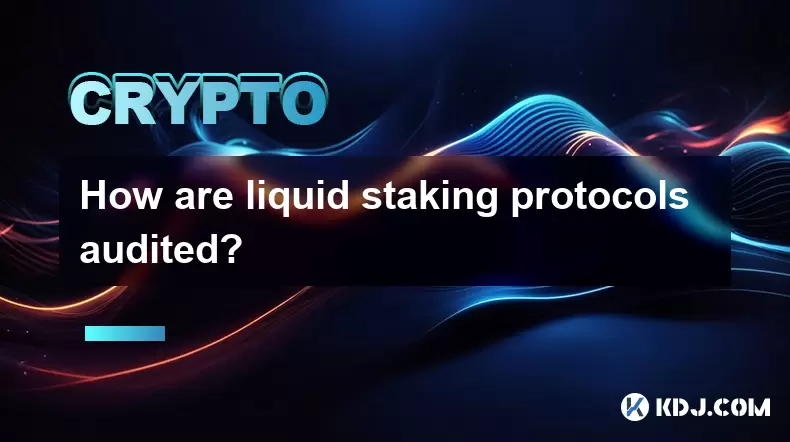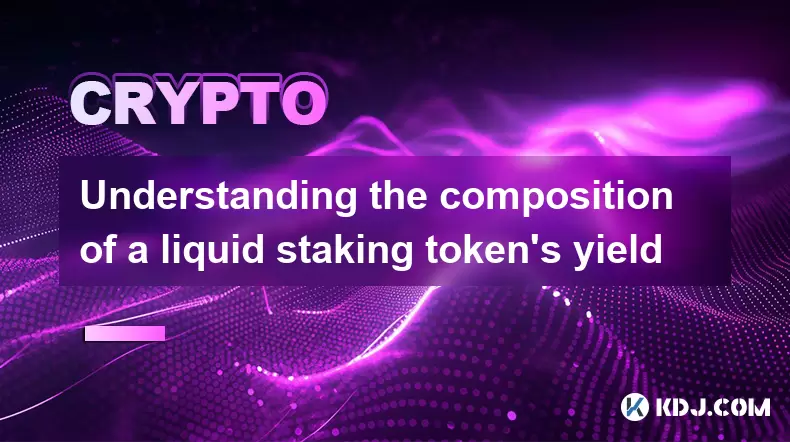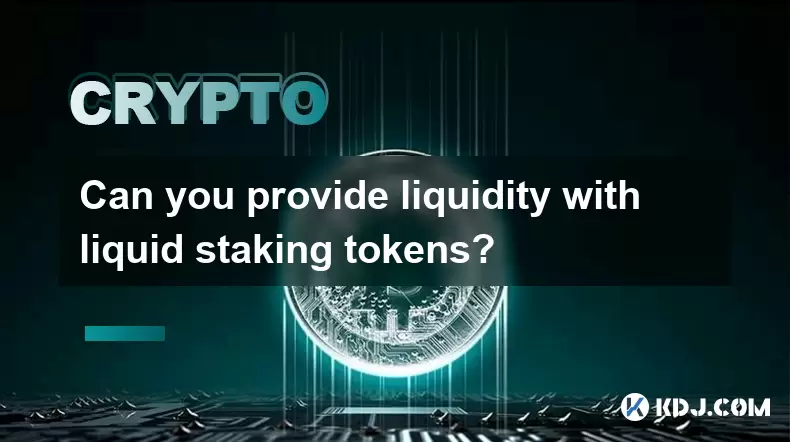-
 bitcoin
bitcoin $100977.009184 USD
-2.05% -
 ethereum
ethereum $3282.009150 USD
-3.23% -
 tether
tether $0.999813 USD
-0.02% -
 xrp
xrp $2.208254 USD
-4.89% -
 bnb
bnb $951.411089 USD
0.55% -
 solana
solana $155.761205 USD
-2.84% -
 usd-coin
usd-coin $1.000217 USD
0.02% -
 tron
tron $0.284475 USD
-1.28% -
 dogecoin
dogecoin $0.162363 USD
-1.53% -
 cardano
cardano $0.533988 USD
-0.47% -
 hyperliquid
hyperliquid $39.174339 USD
-3.22% -
 chainlink
chainlink $14.724828 USD
-1.16% -
 bitcoin-cash
bitcoin-cash $477.297986 USD
-1.28% -
 zcash
zcash $554.227426 USD
17.30% -
 ethena-usde
ethena-usde $0.998995 USD
-0.03%
How are liquid staking protocols audited?
Liquid staking protocols enhance DeFi capital efficiency but require rigorous audits to address smart contract risks, validator misbehavior, and economic vulnerabilities.
Jul 30, 2025 at 05:43 am

Understanding the Basics of Liquid Staking Protocols
Liquid staking protocols allow users to stake their assets while receiving a tokenized representation of their staked assets, which can be used across decentralized finance (DeFi) platforms. This mechanism enhances capital efficiency but introduces complex smart contract risks, validator misbehavior, and liquidity issues. Auditing these protocols is critical to ensure the security of user funds, integrity of the network, and trust in the ecosystem.
Liquid staking requires a multi-layered approach to auditing, covering both the on-chain smart contracts and the off-chain validator operations. Unlike traditional DeFi protocols, liquid staking involves interactions with consensus layer protocols like Ethereum 2.0, which adds an additional layer of complexity to the auditing process.
Smart Contract Security Audits
The foundation of any liquid staking protocol lies in its smart contracts. These contracts manage the issuance, redemption, and rebalancing of liquid staking tokens (LSTs). A comprehensive audit of these contracts involves:
- Code review by experienced blockchain security professionals to identify vulnerabilities such as reentrancy, overflow/underflow, and improper access controls.
- Formal verification tools to mathematically prove the correctness of contract logic, especially for critical functions like token minting and burning.
- Fuzzing and testing with automated tools to simulate edge cases and unexpected inputs.
- Third-party audits from reputable firms like Trail of Bits, CertiK, or OpenZeppelin to ensure an independent assessment.
These audits should be repeated with every major upgrade or integration, especially when the protocol integrates with new chains or DeFi platforms.
Validator and Beacon Chain Audits
Unlike traditional staking, liquid staking protocols operate or interface with validator nodes on the consensus layer. This introduces the need to audit both the validator client software and the beacon chain interactions.
- Validator client audits ensure that the software running on validator nodes is secure and free from exploits that could lead to slashing penalties.
- Beacon chain data validation checks that the protocol correctly interprets and reacts to events like validator balance changes, withdrawal credentials, and exit events.
- Slashing risk mitigation involves verifying that the protocol has mechanisms to prevent or recover from slashing events, including insurance funds or diversification across validators.
Audit teams often simulate slashing scenarios to evaluate the protocol's resilience and recovery mechanisms. These audits are especially crucial for protocols that run their own validator infrastructure or pool stake from multiple users.
Tokenomics and Economic Risk Audits
The economic model of a liquid staking protocol must be scrutinized to ensure long-term sustainability and fair reward distribution. Audits in this area focus on:
- Reward distribution logic to ensure accurate and fair allocation of staking rewards to LST holders.
- Rebase and peg mechanisms that maintain the value of the LST relative to the underlying asset.
- Inflation and dilution risks that may affect long-term holders if the protocol issues new tokens improperly.
- Oracle dependencies for price feeds or beacon chain data, which could be manipulated if not properly secured.
These audits often involve simulations and stress tests to evaluate how the protocol behaves under various network conditions and market scenarios.
Operational and Governance Audits
Many liquid staking protocols are governed by decentralized autonomous organizations (DAOs), which introduces operational risks related to governance and upgrades. These audits assess:
- Governance structure and whether it allows for secure, transparent decision-making without centralization risks.
- Emergency shutdown mechanisms to halt operations in case of critical vulnerabilities or exploits.
- Multi-signature and timelock controls to prevent unauthorized or rushed upgrades.
- Transparency and reporting practices, including on-chain logs and public dashboards for validator performance and LST peg stability.
These audits help ensure that the protocol remains resilient not only from a technical standpoint but also from a governance and operational perspective.
Frequently Asked Questions
What happens if a liquid staking protocol gets hacked despite being audited?
Even audited protocols can be vulnerable to novel attack vectors or exploits that were not identified during the audit. In such cases, the protocol should have emergency pause mechanisms, insurance funds, or decentralized governance proposals to respond swiftly and protect user funds.
Are all liquid staking audits performed by third-party firms?
While many audits are conducted by third-party firms, some protocols also conduct internal audits and community bug bounty programs. However, third-party audits are generally considered more credible and comprehensive, especially when performed by well-established security firms.
How often should a liquid staking protocol undergo an audit?
A protocol should be audited before launch, after major upgrades, and periodically (typically every 6–12 months). Additionally, audits should be triggered when integrating with new blockchains or DeFi protocols to ensure compatibility and security.
Can users verify the results of an audit themselves?
Yes, most reputable protocols publish their audit reports publicly. Users can review these reports to understand the scope, findings, and recommendations. Some audits also include interactive tools or dashboards that allow users to track the resolution of identified issues.
Disclaimer:info@kdj.com
The information provided is not trading advice. kdj.com does not assume any responsibility for any investments made based on the information provided in this article. Cryptocurrencies are highly volatile and it is highly recommended that you invest with caution after thorough research!
If you believe that the content used on this website infringes your copyright, please contact us immediately (info@kdj.com) and we will delete it promptly.
- BlockDAG, Avalanche, Dogecoin: Crypto's Leading Trio in 2025
- 2025-11-07 22:05:01
- Layer 2 Coins: Will There Be a Potential Explosion by 2026?
- 2025-11-07 16:50:02
- Filecoin, ICP, and the AI Infrastructure Renaissance: Is History Repeating?
- 2025-11-07 16:50:02
- Bitcoin's Wild Ride: Surges, Zeros, and the Search for Stability
- 2025-11-07 17:05:01
- XRP, Bitcoin, and the Rally: What's the Deal, New York?
- 2025-11-07 17:25:01
- Filecoin, DePIN, and a Technical Breakout: What's the Buzz?
- 2025-11-07 17:05:01
Related knowledge

Understanding the composition of a liquid staking token's yield
Jul 20,2025 at 09:07am
What Is a Liquid Staking Token?A liquid staking token is a representative asset issued to users who stake their native cryptocurrency on a proof-of-st...

Is it better to stake directly or use a liquid staking service?
Jul 22,2025 at 08:21pm
Understanding the Basics of StakingStaking in the context of blockchain and cryptocurrency refers to the process of locking up digital assets to suppo...

What to do during an LST depeg event
Jul 20,2025 at 04:57pm
Understanding LST Depeg EventsAn LST (Liquid Staking Token) depeg event occurs when the token, which is typically pegged to the value of the underlyin...

How to find new liquid staking projects
Jul 30,2025 at 01:14pm
Understanding Liquid Staking and Its ImportanceLiquid staking is a mechanism that allows users to stake their cryptocurrency assets while still mainta...

Can you provide liquidity with liquid staking tokens?
Jul 22,2025 at 10:22am
Understanding Liquid Staking TokensLiquid staking tokens (LSTs) are derivative tokens that represent staked assets on a proof-of-stake (PoS) blockchai...

What are the best wallets for storing LSTs?
Jul 21,2025 at 03:14pm
Understanding LSTs and the Need for Secure StorageLSTs, or Liquid Staking Tokens, are derivative tokens representing staked assets on a blockchain. Wh...

Understanding the composition of a liquid staking token's yield
Jul 20,2025 at 09:07am
What Is a Liquid Staking Token?A liquid staking token is a representative asset issued to users who stake their native cryptocurrency on a proof-of-st...

Is it better to stake directly or use a liquid staking service?
Jul 22,2025 at 08:21pm
Understanding the Basics of StakingStaking in the context of blockchain and cryptocurrency refers to the process of locking up digital assets to suppo...

What to do during an LST depeg event
Jul 20,2025 at 04:57pm
Understanding LST Depeg EventsAn LST (Liquid Staking Token) depeg event occurs when the token, which is typically pegged to the value of the underlyin...

How to find new liquid staking projects
Jul 30,2025 at 01:14pm
Understanding Liquid Staking and Its ImportanceLiquid staking is a mechanism that allows users to stake their cryptocurrency assets while still mainta...

Can you provide liquidity with liquid staking tokens?
Jul 22,2025 at 10:22am
Understanding Liquid Staking TokensLiquid staking tokens (LSTs) are derivative tokens that represent staked assets on a proof-of-stake (PoS) blockchai...

What are the best wallets for storing LSTs?
Jul 21,2025 at 03:14pm
Understanding LSTs and the Need for Secure StorageLSTs, or Liquid Staking Tokens, are derivative tokens representing staked assets on a blockchain. Wh...
See all articles





















![The Graph Price Prediction [GRT Crypto Price News Today] The Graph Price Prediction [GRT Crypto Price News Today]](/uploads/2025/11/07/cryptocurrencies-news/videos/690d4df44fe69_image_500_375.webp)




















































